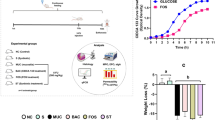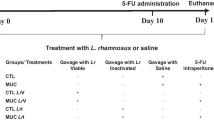Abstract
Purpose
This study investigates whether post-chemotherapeutic use of live and heat-killed Lactobacillus rhamnosus GG can modulate the expression of three pro-inflammatory cytokines in 5-fluorouracil (5-FU)-induced intestinal mucositis in vitro.
Methods
Live L. rhamnosus GG and heat-killed L. rhamnosus GG were observed using scanning electron microscopy. To establish the duration required for optimal expression of tumor necrosis factor-α (TNF-α), monocyte chemotactic protein-1 (MCP-1), and interleukin-12 (IL-12), 5 μM of 5-FU was selected to treat 10-day-old Caco-2 cells for 4, 6, 8, and 24 h. Caco-2 cells were treated with 5-FU (5 μM) for 4 h, followed by the administration of live L. rhamnosus GG (multiplicity of infection = 25), and heat-killed L. rhamnosus GG for 2 and 4 h. Finally, total cellular RNA was isolated to quantify mRNA expression of TNF-α, MCP-1, and IL-12 using real-time PCR.
Results
The results demonstrated that heat-killed L. rhamnosus GG remained structurally intact with elongation. A biphasic upregulated expression of TNF-α, MCP-1, and IL-12 was observed in 5-FU-treated Caco-2 cells at 4 and 24 h. Compared to non-L. rhamnosus GG controls in 5-FU-pretreated Caco-2 cells, a 2-h treatment of heat-killed L. rhamnosus GG significantly upregulated the MCP-1 expression (p < 0.05), and both live and heat-killed L. rhamnosus GG treatments lasting 4 h upregulated the TNF-α and MCP-1 expression (p < 0.05). Only live L. rhamnosus GG upregulated the IL-12 expression (p < 0.05).
Conclusions
Post-chemotherapeutic use of live or heat-killed L. rhamnosus GG can upregulate the gene expression of 5-FU-induced pro-inflammatory cytokines in Caco-2 cells. Human intestinal epithelium may be vulnerable to the post-chemotherapeutic use of L. rhamnosus GG in 5-FU-induced mucositis that requires further in vivo studies for clarification.





Similar content being viewed by others
References
Elting LS, Cooksley C, Chambers M, Cantor SB, Manzullo E, Rubenstein EB (2003) The burdens of cancer therapy. Clinical and economic outcomes of chemotherapy-induced mucositis. Cancer 98:1531–1539
Keefe DM (2004) Gastrointestinal mucositis: a new biological model. Support Care Cancer 12:6–9
Thorpe DW, Stringer AM, Gibson RJ (2013) Chemotherapy-induced mucositis: the role of the gastrointestinal microbiome and toll-like receptors. Exp Biol Med (Maywood) 238:1–6
Sonis ST, Elting LS, Keefe D, Peterson DE, Schubert M, Hauer-Jensen M, Bekele BN, Raber-Durlacher J, Donnelly JP, Rubenstein EB (2004) Perspectives on cancer therapy-induced mucosal injury: pathogenesis, measurement, epidemiology, and consequences for patients. Cancer 100:1995–2025
Chang CT, Ho TY, Lin H, Liang JA, Huang HC, Li CC, Lo HY, Wu SL, Huang YF, Hsiang CY (2012) 5-Fluorouracil induced intestinal mucositis via nuclear factor-kappaB activation by transcriptomic analysis and in vivo bioluminescence imaging. PLoS One 7:e31808
Szajewska H, Setty M, Mrukowicz J, Guandalini S (2006) Probiotics in gastrointestinal diseases in children: hard and not-so-hard evidence of efficacy. J Pediatr Gastroenterol Nutr 42:454–475
Osterlund P, Ruotsalainen T, Korpela R, Saxelin M, Ollus A, Valta P, Kouri M, Elomaa I, Joensuu H (2007) Lactobacillus supplementation for diarrhoea related to chemotherapy of colorectal cancer: a randomised study. Br J Cancer 97:1028–1034
Mauger CA, Butler RN, Geier MS, Tooley KL, Howarth GS (2007) Probiotic effects on 5-fluorouracil-induced mucositis assessed by the sucrose breath test in rats. Dig Dis Sci 52:612–619
Prisciandaro LD, Geier MS, Chua AE, Butler RN, Cummins AG, Sander GR, Howarth GS (2012) Probiotic factors partially prevent changes to caspases 3 and 7 activation and transepithelial electrical resistance in a model of 5-fluorouracil-induced epithelial cell damage. Support Care Cancer 20:3205–3210
Guarner F, Schaafsma GJ (1998) Probiotics. Int J Food Microbiol 39:237–238
MacGregor G, Smith AJ, Thakker B, Kinsella J (2002) Yoghurt biotherapy: contraindicated in immunosuppressed patients? Postgrad Med J 78:366–367
Li N, Russell WM, Douglas-Escobar M, Hauser N, Lopez M, Neu J (2009) Live and heat-killed Lactobacillus rhamnosus GG: effects on proinflammatory and anti-inflammatory cytokines/chemokines in gastrostomy-fed infant rats. Pediatr Res 66:203–207
Xiao SD, Zhang DZ, Lu H, Jiang SH, Liu HY, Wang GS, Xu GM, Zhang ZB, Lin GJ, Wang GL (2003) Multicenter, randomized, controlled trial of heat-killed Lactobacillus acidophilus LB in patients with chronic diarrhea. Adv Ther 20:253–260
Sonnier DI, Bailey SR, Schuster RM, Gangidine MM, Lentsch AB, Pritts TA (2012) Proinflammatory chemokines in the intestinal lumen contribute to intestinal dysfunction during endotoxemia. Shock 37:63–69
Schauer MC, Holzmann B, Peiper M, Friess H, Knoefel WT, Theisen J (2010) Interleukin-10 and -12 predict chemotherapy-associated toxicity in esophageal adenocarcinoma. J Thorac Oncol 5:1849–1854
Schüller S, Lucas M, Kaper JB, Giron JA, Phillips AD (2009) The ex vivo response of human intestinal mucosa to enteropathogenic Escherichia coli infection. Cell Microbiol 11:521–530
Thirabunyanon M, Boonprasom P, Niamsup P (2009) Probiotic potential of lactic acid bacteria isolated from fermented dairy milks on antiproliferation of colon cancer cells. Biotechnol Lett 31:571–576
Jordan A, Stein J (2003) Effect of an omega-3 fatty acid containing lipid emulsion alone and in combination with 5-fluorouracil (5-FU) on growth of the colon cancer cell line Caco-2. Eur J Nutr 42:324–331
Haller D, Blum S, Bode C, Hammes WP, Schiffrin EJ (2000) Activation of human peripheral blood mononuclear cells by nonpathogenic bacteria in vitro: evidence of NK cells as primary targets. Infect Immun 68:752–759
Saegusa S, Totsuka M, Kaminogawa S, Hosoi T (2007) Cytokine responses of intestinal epithelial-like Caco-2 cells to non-pathogenic and opportunistic pathogenic yeasts in the presence of butyric acid. Biosci Biotechnol Biochem 71:2428–2434
Murzyn A, Krasowska A, Augustyniak D, Majkowska-Skrobek G, Lukaszewicz M, Dziadkowiec D (2010) The effect of Saccharomyces boulardii on Candida albicans-infected human intestinal cell lines Caco-2 and Intestin 407. FEMS Microbiol Lett 310:17–23
Livak KJ, Schmittgen TD (2001) Analysis of relative gene expression data using real-time quantitative PCR and the 2−ΔΔCT method. Methods 25:402–408
Logan RM, Stringer AM, Bowen JM, Yeoh AS, Gibson RJ, Sonis ST, Keefe DM (2007) The role of pro-inflammatory cytokines in cancer treatment-induced alimentary tract mucositis: pathobiology, animal models and cytotoxic drugs. Cancer Treat Rev 33:448–460
Naidu MU, Ramana GV, Rani PU, Mohan IK, Suman A, Roy P (2004) Chemotherapy-induced and/or radiation therapy-induced oral mucositis—complicating the treatment of cancer. Neoplasia 6:423–431
Sakai H, Sagara A, Matsumoto K, Hasegawa S, Sato K, Nishizaki M, Shoji T, Horie S, Nakagawa T, Tokuyama S, Narita M (2013) 5-Fluorouracil induces diarrhea with changes in the expression of inflammatory cytokines and aquaporins in mouse intestines. PLoS One 8:e54788
Ferreira TM, Leonel AJ, Melo MA, Santos RR, Cara DC, Cardoso VN, Correia MI, varez-Leite JI (2012) Oral supplementation of butyrate reduces mucositis and intestinal permeability associated with 5-fluorouracil administration. Lipids 47:669–678
Shiota A, Hada T, Baba T, Sato M, Yamanaka-Okumura H, Yamamoto H, Taketani Y, Takeda E (2010) Protective effects of glycoglycerolipids extracted from spinach on 5-fluorouracil induced intestinal mucosal injury. J Med Invest 57:314–320
Soares PM, Lima-Junior RC, Mota JM, Justino PF, Brito GA, Ribeiro RA, Cunha FQ, Souza MH (2011) Role of platelet-activating factor in the pathogenesis of 5-fluorouracil-induced intestinal mucositis in mice. Cancer Chemother Pharmacol 68:713–720
Reinecker HC, Loh EY, Ringler DJ, Mehta A, Rombeau JL, MacDermott RP (1995) Monocyte-chemoattractant protein 1 gene expression in intestinal epithelial cells and inflammatory bowel disease mucosa. Gastroenterology 108:40–50
Mahoney SE, Davis JM, Murphy EA, McClellan JL, Gordon B, Pena MM (2013) Effects of 5-fluorouracil chemotherapy on fatigue: role of MCP-1. Brain Behav Immun 27:155–161
Sergent T, Piront N, Meurice J, Toussaint O, Schneider YJ (2010) Anti-inflammatory effects of dietary phenolic compounds in an in vitro model of inflamed human intestinal epithelium. Chem Biol Interact 188:659–667
Lan JG, Cruickshank SM, Singh JC, Farrar M, Lodge JP, Felsburg PJ, Carding SR (2005) Different cytokine response of primary colonic epithelial cells to commensal bacteria. World J Gastroenterol 11:3375–3384
Kaufman HL, Swartout BG, Horig H, Lubensky I (2002) Combination interleukin-2 and interleukin-12 induces severe gastrointestinal toxicity and epithelial cell apoptosis in mice. Cytokine 17:43–52
Jun CD, Kim Y, Choi EY, Kim M, Park B, Youn B, Yu K, Choi KS, Yoon KH, Choi SC, Lee MS, Park KI, Choi M, Chung Y, Oh J (2006) Gliotoxin reduces the severity of trinitrobenzene sulfonic acid-induced colitis in mice: evidence of the connection between heme oxygenase-1 and the nuclear factor-кB pathway in vitro and in vivo. Inflamm Bowel Dis 12:619–629
Zhao J, Huang L, Belmar N, Buelow R, Fong T (2004) Oral RDP58 allows CPT-11 dose intensification for enhanced tumor response by decreasing gastrointestinal toxicity. Clin Cancer Res 10:2851–2859
Mattick KL, Rowbury RJ, Humphrey TJ (2003) Morphological changes to Escherichia coli O157:H7, commensal E. coli and Salmonella spp in response to marginal growth conditions, with special reference to mildly stressing temperatures. Sci Prog 86:103–113
Donato KA, Gareau MG, Wang YJ, Sherman PM (2010) Lactobacillus rhamnosus GG attenuates interferon-γ and tumour necrosis factor-α-induced barrier dysfunction and pro-inflammatory signalling. Microbiology 156:3288–3297
Szajewska H, Skorka A, Ruszczynski M, Gieruszczak-Bialek D (2007) Meta-analysis: Lactobacillus GG for treating acute diarrhoea in children. Aliment Pharmacol Ther 25:871–881
Nomoto K, Yokokura T, Nomoto K (1992) Prevention of 5-fluorouracil-induced infection with indigenous Escherichia coli in tumor-bearing mice by nonspecific immunostimulation. Can J Microbiol 38:774–778
Fang HW, Fang SB, Chiang Chiau JS, Yeung CY, Chan WT, Jiang CB, Cheng ML, Lee HC (2010) Inhibitory effects of Lactobacillus casei subsp. rhamnosus on Salmonella lipopolysaccharide-induced inflammation and epithelial barrier dysfunction in a co-culture model using Caco-2/peripheral blood mononuclear cells. J Med Microbiol 59:573–579
Von BI, Adlerberth I, Wold AE, Dahlen G, Jontell M (2003) Oral and intestinal microflora in 5-fluorouracil treated rats, translocation to cervical and mesenteric lymph nodes and effects of probiotic bacteria. Oral Microbiol Immunol 18:278–284
Smith CL, Geier MS, Yazbeck R, Torres DM, Butler RN, Howarth GS (2008) Lactobacillus fermentum BR11 and fructo-oligosaccharide partially reduce jejunal inflammation in a model of intestinal mucositis in rats. Nutr Cancer 60:757–767
Acknowledgments
This study was funded by the Taipei Medical University (TMU101-AE1-B64), the National Health Research Institutes (ME-101-PP-12), and the National Taipei University of Technology (NTUT-MMH-101-07). We thank Professor Liang-Shun Wang, Dr. Wei-Ming Chi, and Dr. Chi-Tai Yeh for their assistance in the laboratory.
Conflict of interest
I, Shiuh-Bin Fang, state that there is no conflict of interest associated with this manuscript. I declare that I have no financial relationship with the organizations that funded the research. The authorship of this manuscript is as described in the attached Authorship/Disclosure form, with myself as the first author. I have full control of all primary data related to this manuscript and agree to allow the journal to review the data if necessary.
Author information
Authors and Affiliations
Corresponding authors
Rights and permissions
About this article
Cite this article
Fang, SB., Shih, HY., Huang, CH. et al. Live and heat-killed Lactobacillus rhamnosus GG upregulate gene expression of pro-inflammatory cytokines in 5-fluorouracil-pretreated Caco-2 cells. Support Care Cancer 22, 1647–1654 (2014). https://doi.org/10.1007/s00520-014-2137-z
Received:
Accepted:
Published:
Issue Date:
DOI: https://doi.org/10.1007/s00520-014-2137-z




